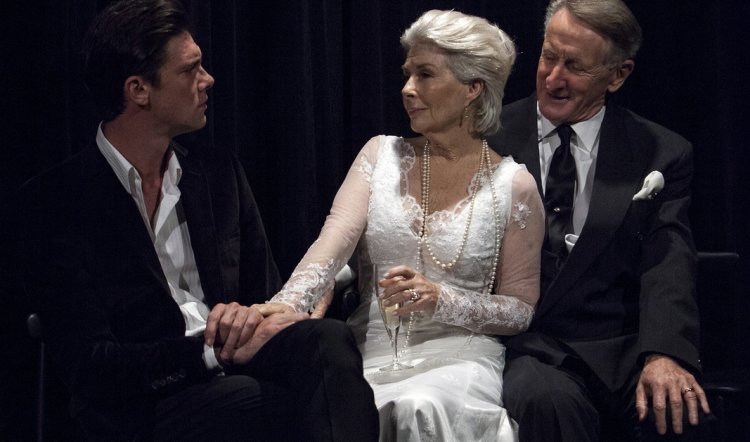
HAMLET
HAMLET, Belvoir at Upstairs Belvoir, 16 October-1 December 2013, Photography by Brett Boardman: Toby Schmitz, Robyn Nevin and John Gaden; right: Toby Schmitz.
"Every generation feels the irresistible compulsion to attempt to stage this, the greatest play by the greatest playwright. Then, when we try, we're haunted by the ghosts of past Hamlets: Olivier, Gielgud…Roxburgh." Not sure who wrote this blurb on the Belvoir website but if you're going to make such a silly assertion and even sillier list, you'd have to add Lindsay Farris to it, just for balance.
Sadly, the compressed and brilliant Hamlet of 2012-13 by Damien Ryan and Sport For Jove was so much better than this - and still close enough in memory for a credible comparison (much as I dislike such comparisons, in general) - that it's ridiculous to omit its Hamlet from any contemporary reckoning of Shakespeare's wondrous play. But the blurb continues: "It takes the perfect combination of director and leading man to tackle this perennial conundrum [how to really become Hamlet] - to face up to the ghosts and plunge into the thing itself with clear eyes."
In the end, hubris will get you every time. In this instance, the "perfect combination" of director Simon Stone and leading man Toby Schmitz delivers a curate's egg: brilliant moments and a fair amount of banality in between. There's also an ill thought out choice made along the way that turns the final five minutes into something approaching farce - but more of that in a minute.
First the good things: Robyn Nevin as Hamlet's mother, Queen Gertrude is wonderful - the play comes alive and has real meaning when she's the focus. Sadly, this doesn't happen enough, but many of the flashes of brilliance involve her. Whether she's elegantly pissed and teetering, champagne glass in hand, or when she is brutally confronted by her son's rage and grief, Nevin is actually the perfect combination - of heart and head, years and energy, intelligence and wit. Being forced by Hamlet to face the reality of her marriage to her dead husband's usurping and unctuous brother (a wickedly oleaginous John Gaden) and what it means to him is this production's climactic and most meaningful scene.
Hamlet's play scene is another dramatic and visual highlight. The prince wheels on an elaborate toy theatre and begins to entertain his mother and the royal entourage. This production is stripped of many of the usual human participants however, so Hamlet performs his play with puppets. He's no lonely goatherd though, this Hamlet is a mischievous and cunning artiste and as the drama unfolds - apparently and undiplomatically a reflection of their own lives - the uncanny resemblance between the string-operated thespians and their human models makes for a witty play on who exactly is pulling their strings.
Designer Ralph Myers devised and puppet maker Bridget Dolan fabricated the puppets and they're classic and clever. Also effective, if familiar, is the motif of a plain black first half and stark white second (sharp lighting designed by Benjamin Cisterne) and contemporary costumes in the same vein. In the second half the vein comes into its own as the austere black and white is gradually enlivened by a lot of pleasingly red blood.
Also missing in action are Rosencrantz and Guildenstern, replaced by the singular figure of Nathan Lovejoy who represents the friends and courtiers of the unhappy prince. Thomas Campbell is a restrained and strong Laertes, Greg Stone a fine Polonius and Emily Barclay is a sweetly piteous Ophelia. The thread that runs through the two-hours-plus descent into murder and madness is the addition of Luke Byrne, at a grand piano throughout, and counter tenor Maximilian Riebl. The play opens with an almost inaudible riff on Satie's Gymnopedie that gradually takes on form, focus and warmth. Indeed, composer and sound designer Stefan Gregory paints in most of the colour in this elegantly monotonal world.
The other dramatic coup is to have the dead remain on stage throughout, as observers and (by the audience and Hamlet) the observed. It's a striking and effective way of explaining Hamlet's "visions" - when his father (mesmerising Anthony Phelan) is present and neither the drifting ghost nor the man he knew and loved. It becomes even more powerful when he is gradually joined by the rest of the murdered courtiers.

Yet much of the good work is undone in the final minutes by a decision made much earlier in the piece. Instead of the traditional foil - as frequently mentioned in Stone's text - the murder weapon is a pistol, in keeping with the mod minimalism of this Elsinore. It's initially unproblematic and makes for a startling and effective twist on Polonius's killing. But, like so many apparently good ideas adopted in the enthusiasm of the moment, nobody asked the vital question "and then what?" That's when ill-thought out ideas should come to grief, but the question is rarely asked, so instead, it's the brainwave that brings down the greater endeavour.
This is what happens with Hamlet's pistol. When it comes to the multiple deaths, whether by poison or by sharp blade, the gun has already murdered logic. The immortal (and retained) exclamation of "a hit, a palpable hit!" is simply daft when the aggressor is brandishing a gun and the other man is doing and holding nothing. It also immediately raises the unanswerable - so what about the poison? To have it or not to have it - that is the question. And it's answered in the worst way possible.
The climactic scene of mass killing is performed in a standing circle without weapons or visible potions. When Gertrude drinks from the fatal chalice meant for her son she remains steadfastly upright, emitting a series of duck-like quacks that are simply comical. On opening night I wasn't the only one trying to stifle giggles and in a moment of tragedy, that's disaster. It would be comforting to believe the Miley Cyrus tongue acting and squawks are the wily Nevin's way of subverting the silly enterprise - who knows.
An actor friend commented later that not only was she also swallowing giggles, but also was unmoved by the scene. Rather, she said, "That circle of actors at the end killing each other without props reminded me of the voice exercises they'd make us do in first year NIDA, you know: 'And now, we shall perform the Battle of Trafalgar - with consonants'!" And that's not only an accurate description of what should be a scene dripping with blood and tears, but also highlights the other chasm into which this Hamlet falls. It's not supposed to be funny - except in flashes. It's definitely not going to work when the word "rollicking" can be used in a description.
The company blurb mentioned above also tells us: "Director Simon Stone is ruthless and visionary in his pursuit of the essential in a text; Toby Schmitz is one of the great actors of his generation: quick, droll and fiendishly sharp." Stone would have helped the wonderful Schmitz immeasurably if he had been ruthless with him: and kept him under control and on track. Trouble is, Schmitz can be too quick, droll and sharp for his own good. Whatever director Simon Phillips said to him for his wonderfully quick, droll and fiendishly sharp performance in the recent Rosencrantz and Guildenstern Are Dead (STC) is what he needed here to be the brilliant creature he can be. In this instance, Schmitz begins at a mugging, twitching, funning canter and is soon at an out-of-control mad gallop. And so there is nowhere else to go - no nuance, no restraint, and therefore less and less effect.
Nevertheless, on opening night there were a rare four curtain calls and a sprinkling of enthusiastic standing ovaters. Many enjoyed it.



